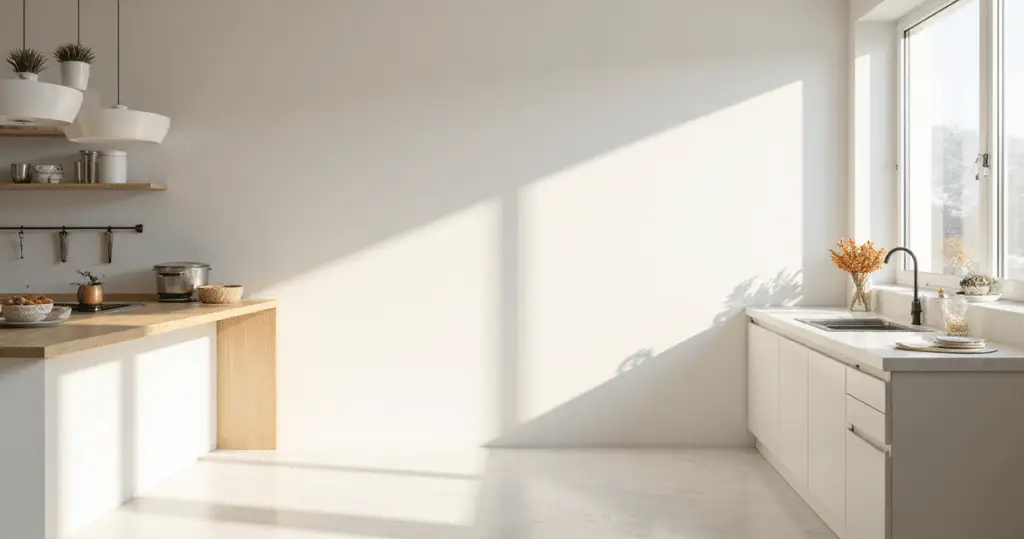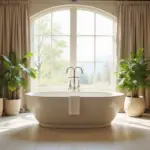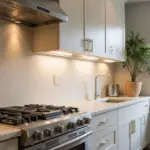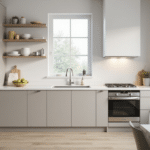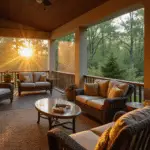The morning light filters through unadorned windows, illuminating pale wood surfaces and crisp white walls that seem to breathe with quiet elegance. This is the essence of Scandinavian kitchen decor – a design philosophy that transforms the heart of your home into a sanctuary of calm functionality. Far beyond mere aesthetics, this approach to kitchen design embraces the Nordic concept of “lagom” – the art of balanced living where every element serves both beauty and purpose.
In our increasingly chaotic world, the kitchen has evolved from a purely utilitarian space into the emotional center of the home. Scandinavian kitchen decor recognizes this shift, creating environments that nurture both body and soul through thoughtful minimalism, natural materials, and an unwavering commitment to functionality. By stripping away the unnecessary and celebrating the essential, these kitchens become spaces where cooking becomes meditation, gathering feels effortless, and daily routines transform into moments of quiet joy.
This comprehensive guide unveils 24 carefully curated ideas that will help you achieve this coveted aesthetic. From foundational choices like lighting and materials to nuanced details like storage and texture, each element works harmoniously to create a kitchen that doesn’t just look serene – it actively promotes well-being through intelligent design.
1. Embrace Pure White Wall Foundations
Pure white walls form the cornerstone of authentic Scandinavian kitchen decor, acting as light amplifiers that transform even the most compact spaces into bright, airy sanctuaries. This isn’t simply about choosing any white – it’s about selecting crisp, clean tones that reflect the maximum amount of natural light while creating a sense of visual expansion that makes your kitchen feel significantly larger than its actual footprint.
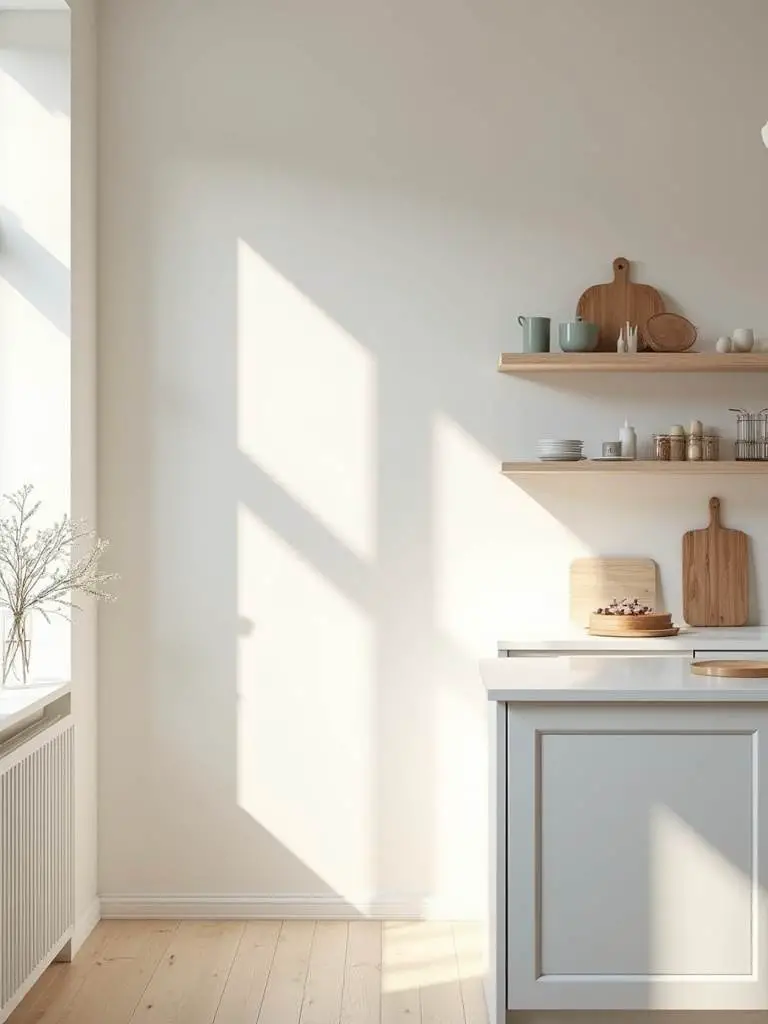
The psychological impact of white walls extends far beyond aesthetics. Research in environmental psychology demonstrates that bright, uncluttered spaces can reduce cortisol levels by up to 15%, directly contributing to a calmer cooking experience. When paired with the Nordic emphasis on natural light, white walls can increase perceived brightness by 70-80%, dramatically reducing the need for artificial lighting during daylight hours and creating that coveted connection to the outdoors that defines Scandinavian living.
- Choose the right white undertone: Test large swatches to see how cool blues or warm creams interact with your natural light
- Select appropriate finishes: Eggshell for walls provides durability while maintaining light reflection
- Layer different sheens: Combine matte walls with semi-gloss trim for subtle depth without visual chaos
The craftsmanship reveals itself in details like proper surface preparation and primer selection, ensuring your white walls maintain their luminous quality for years to come.
2. Maximize Natural Light Through Minimal Window Treatments
Window treatments in Scandinavian kitchen decor follow the principle of “less is more,” prioritizing unobstructed views and maximum light penetration over decorative flourishes. This approach stems from the Nordic necessity of capturing every precious moment of natural light, especially during the long winter months when daylight becomes a treasured commodity.

Removing heavy drapes and ornate valances can increase natural light penetration by up to 70%, creating a dramatic transformation in both the kitchen’s brightness and its connection to the outdoor environment. This design choice also enhances the sense of spaciousness, making even modest kitchens feel expansive and open. The key lies in selecting window coverings that can completely disappear when not needed – think cellular shades that compress to mere inches or sheer linen panels that filter rather than block.
- Opt for bottom-up cellular shades: Maintain privacy while preserving upper window light and views
- Choose translucent materials: Linen or cotton sheers that diffuse rather than eliminate natural light
- Consider bare windows: When privacy permits, embrace completely unadorned windows for maximum impact
What makes this choice better for our planet is the reduced reliance on artificial lighting, cutting energy consumption while creating spaces that naturally regulate circadian rhythms.
3. Select Light Wood Cabinetry for Warmth
Light wood cabinetry, particularly in birch or ash, serves as the warm foundation that prevents Scandinavian kitchen decor from feeling sterile or cold. These pale wood species reflect ambient light beautifully while introducing the organic textures and natural grain patterns that connect your kitchen to the Nordic forest heritage.
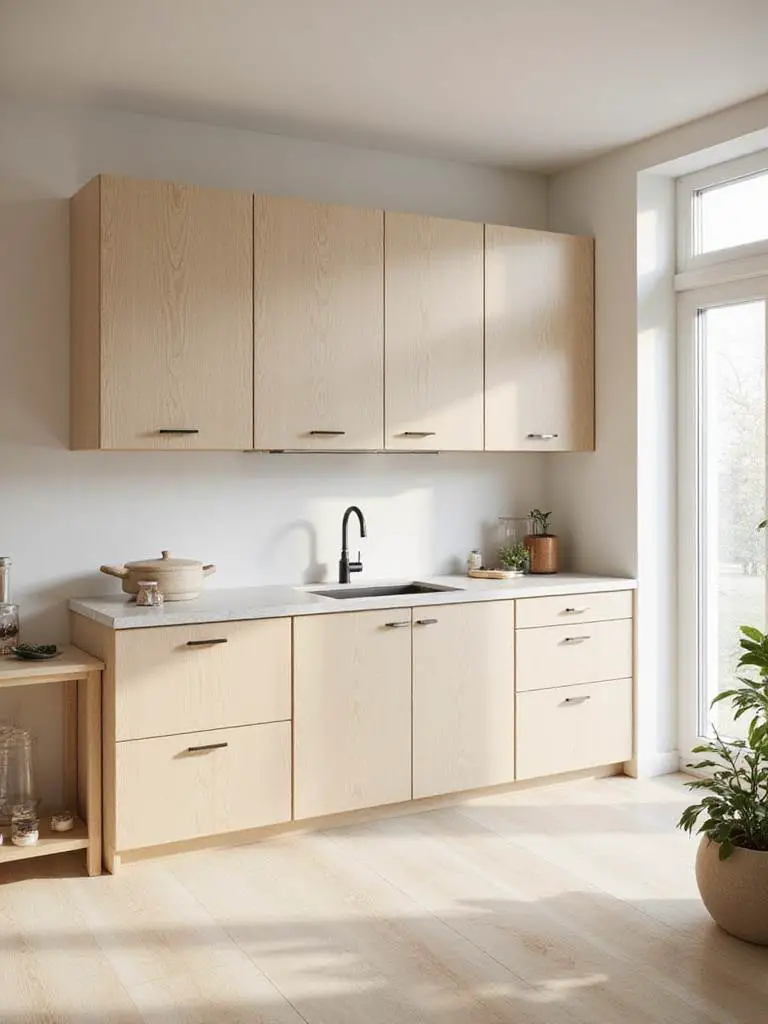
The selection of light wood goes beyond aesthetics – it’s about choosing materials that age gracefully and develop character over time. Birch, with its fine, uniform grain, offers a clean backdrop that complements minimalist design, while ash provides more pronounced grain patterns that add visual interest without overwhelming the space. Both species boast exceptional durability, with Janka hardness ratings that ensure your cabinetry will maintain its beauty through decades of daily use.
Professional stylists approach this by first considering the quality of your natural light, then selecting wood tones that enhance rather than compete with your kitchen’s brightness. The sustainable journey of these materials involves responsible forestry practices that align with Scandinavian environmental values.
4. Install Sleek Handleless Cabinet Systems
Handleless cabinets represent the ultimate expression of minimalist functionality in Scandinavian kitchen decor, creating seamless surfaces that enhance the sense of visual calm while maximizing the impact of natural materials and clean lines. These systems eliminate the visual interruption of hardware, allowing the eye to appreciate the continuous flow of wood grain or painted surfaces.

The technology behind modern handleless systems has evolved significantly, offering push-to-open mechanisms, integrated J-pulls, and servo-drive options that provide smooth, reliable operation while maintaining the clean aesthetic. This approach can increase perceived spaciousness by up to 15% in compact kitchens, as the uninterrupted lines create a sense of visual continuity that tricks the eye into perceiving larger dimensions.
- Choose push-to-open for frequently accessed cabinets: Provides intuitive operation without visible hardware
- Integrate J-pull channels for base cabinets: Offers ergonomic access while maintaining clean lines
- Consider servo-drive for upper cabinets: Gentle touch operation that works beautifully in modern kitchens
The visual weight balances perfectly when you combine different handleless mechanisms, optimizing both functionality and the seamless aesthetic that defines Nordic design.
5. Incorporate Functional Open Shelving
Open shelving in Scandinavian kitchen decor transforms storage into display, creating opportunities to showcase carefully curated collections of ceramics, glassware, and everyday essentials. This approach requires discipline – every visible item must earn its place through both beauty and utility, embodying the Nordic principle that functional objects can be inherently beautiful.
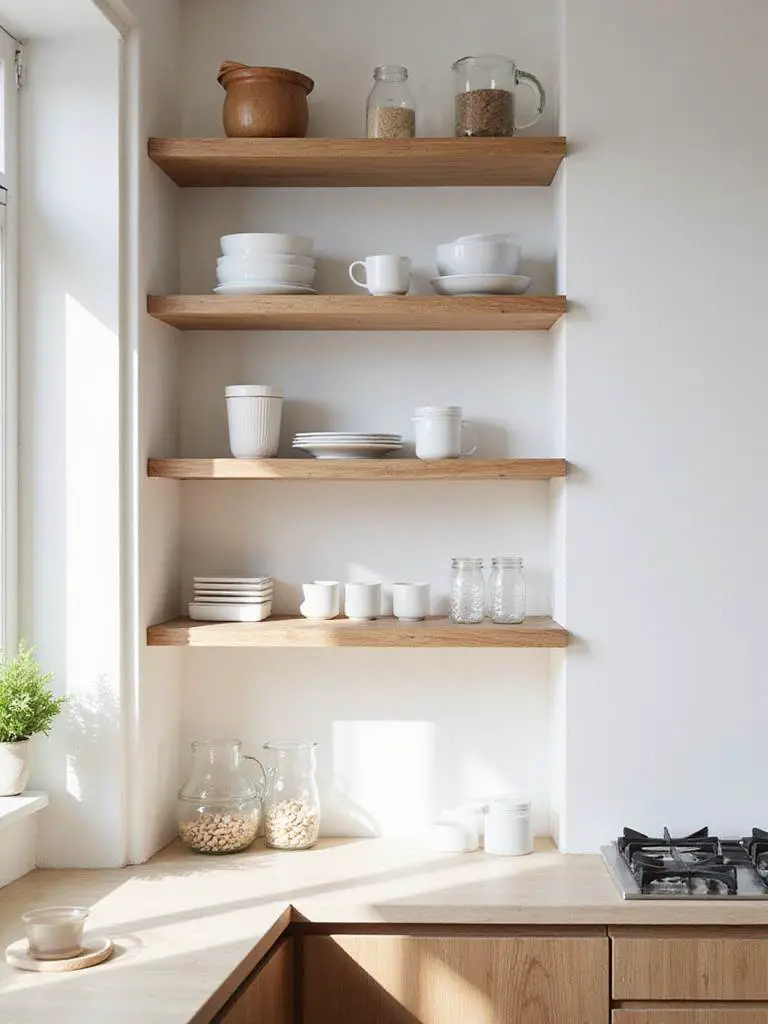
The strategic placement of open shelves can increase perceived kitchen space by up to 20% compared to traditional upper cabinets, as they maintain visual connection to the wall behind while providing essential storage. The key lies in embracing negative space – leaving ample room around displayed items prevents the shelves from appearing cluttered and maintains the serene atmosphere essential to Scandinavian design.
Curating your display involves selecting pieces that tell a cohesive story through color, texture, or material. Group items in odd numbers for visual appeal, and resist the urge to fill every inch of shelf space. The beauty emerges from restraint, allowing each piece to breathe and contribute to the overall composition.
Beyond the obvious placement, consider using open shelving to create zones within your kitchen – a coffee station with mugs and brewing equipment, or a baking area with mixing bowls and measuring tools.
6. Choose Light Wood Flooring for Continuity
Light wood flooring creates the foundation that unifies your Scandinavian kitchen decor with the rest of your home, establishing a cohesive flow that enhances the sense of spaciousness and connection. Species like white oak, ash, or maple provide the durability necessary for kitchen environments while maintaining the bright, airy aesthetic that defines Nordic design.
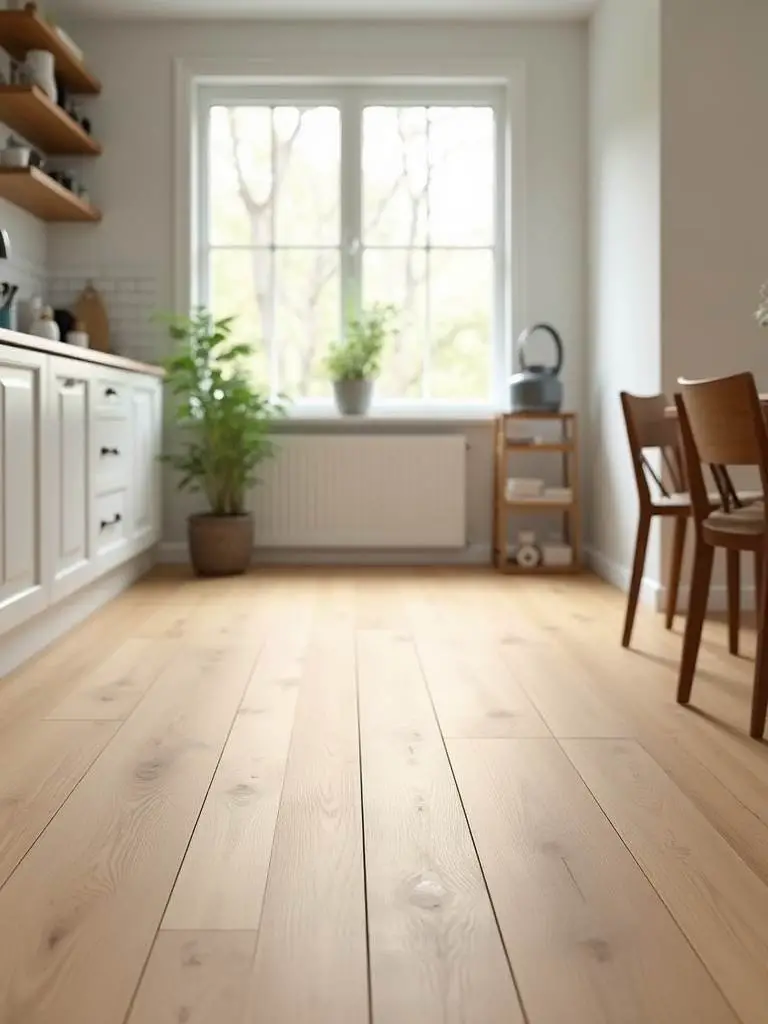
The selection process involves balancing aesthetic goals with practical considerations. Wide-plank flooring emphasizes the natural beauty of the wood grain while creating fewer visual interruptions, making spaces appear larger. The finish choice – whether matte, natural oil, or low-sheen polyurethane – dramatically impacts both the appearance and maintenance requirements of your floors.
- Consider engineered wood for stability: Superior resistance to moisture and temperature fluctuations
- Choose wide planks for visual impact: Creates fewer seam lines and emphasizes natural grain patterns
- Select appropriate finishes: Matte or natural oil finishes minimize visible scratches and provide authentic texture
The environmental story behind sustainable flooring involves responsible harvesting practices and low-VOC finishes that contribute to healthier indoor air quality, aligning with Scandinavian values of environmental stewardship.
7. Layer Natural Fiber Rugs for Comfort
Natural fiber rugs introduce essential warmth and texture to Scandinavian kitchen decor, softening the hard surfaces of wood and stone while adding acoustic comfort that reduces echo and ambient noise. Jute, sisal, and wool each offer distinct characteristics that serve different functional and aesthetic needs within the kitchen environment.
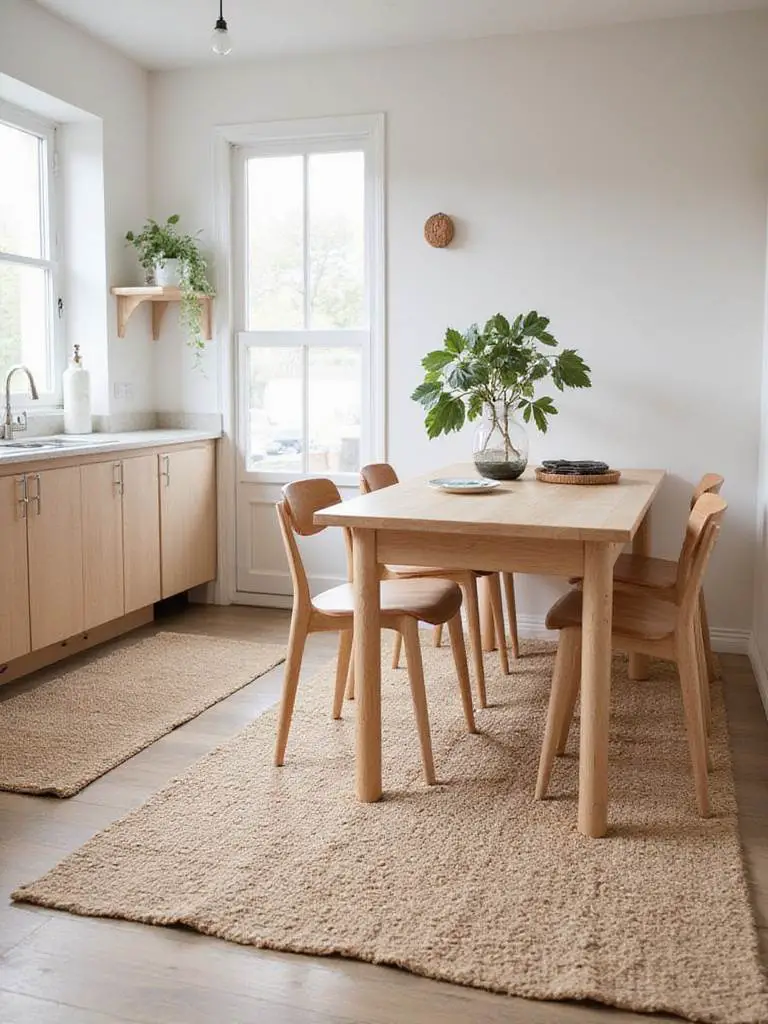
The placement of rugs requires careful consideration of both traffic patterns and visual composition. A properly sized rug beneath a kitchen island should accommodate bar stools when pulled out, while runners along galley kitchens should provide comfort for standing work without interfering with cabinet access. The neutral tones typical of Scandinavian design – creams, grays, and natural browns – ensure these textiles enhance rather than compete with other design elements.
Wool provides superior comfort underfoot and natural stain resistance, making it ideal for areas where spills might occur. Jute and sisal offer more structured texture and exceptional durability for high-traffic zones, while their natural fibers align with the sustainable principles inherent in Nordic design philosophy.
The tactile experience changes the entire room’s energy when you introduce these organic textures, creating subtle zones of comfort that encourage lingering and social interaction.
8. Integrate Living Plants for Biophilic Connection
Plants serve as living sculptures in Scandinavian kitchen decor, introducing organic shapes, natural air purification, and the psychological benefits of biophilic design. The selection process involves matching plant requirements with kitchen conditions – considering light levels, humidity from cooking, and temperature fluctuations near appliances.
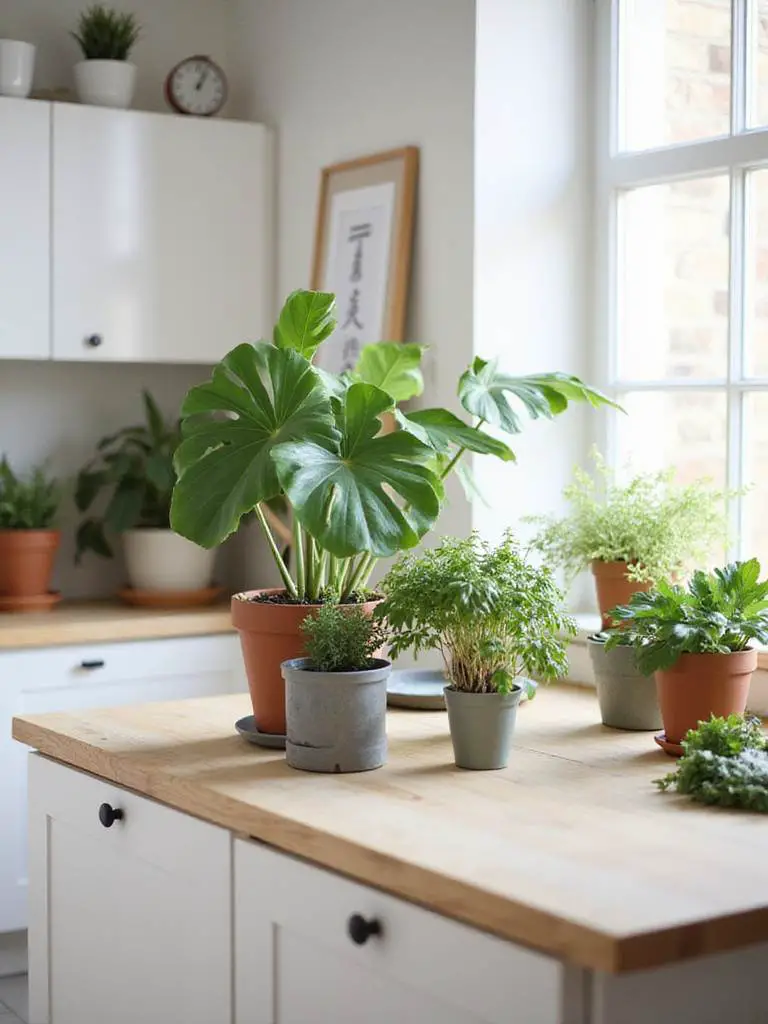
Herbs grown on sunny windowsills provide the perfect marriage of form and function, offering fresh ingredients while contributing to the kitchen’s visual appeal. Larger statement plants like fiddle leaf figs or snake plants can anchor corners or islands, while trailing plants on open shelving add softness and movement to geometric kitchen lines.
- Choose low-maintenance varieties: Snake plants, pothos, and herbs that thrive in kitchen conditions
- Select complementary planters: Natural materials like terracotta, wood, or woven baskets
- Group plants for impact: Create small vignettes with varying heights and leaf textures
The unexpected environmental benefit comes from improved indoor air quality, as plants naturally filter common household toxins while adding humidity that can be particularly beneficial during dry winter months.
9. Install Minimalist Pendant Lighting
Pendant lighting in Scandinavian kitchen decor serves the dual purpose of providing focused task illumination while contributing to the clean, uncluttered aesthetic through simple geometric forms and quality materials. The selection process involves balancing scale, placement, and light quality to enhance both functionality and ambiance.
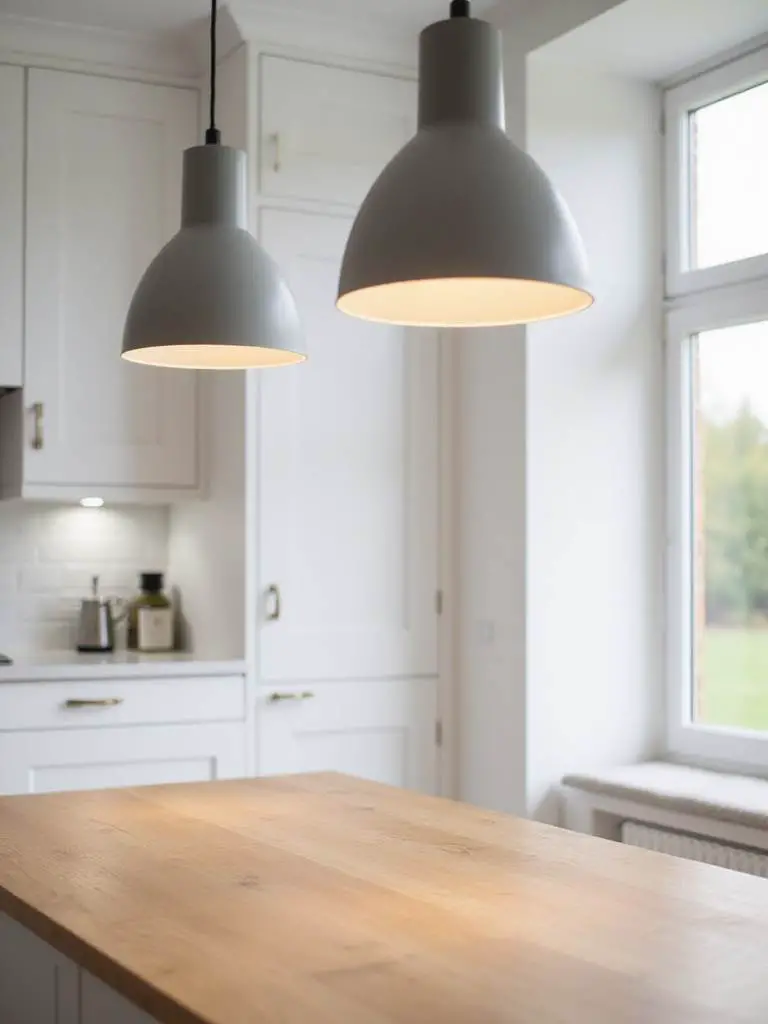
The optimal hanging height – typically 30-36 inches above countertops – ensures adequate task lighting without creating glare or visual obstruction. Modern LED technology allows for warm color temperatures (2700K-3000K) that complement the natural materials and create inviting evening ambiance while providing crisp illumination for food preparation.
Simple geometric shapes – cylinders, spheres, or cones – in materials like matte metals, blown glass, or light wood maintain visual interest without overwhelming the minimalist design. The key lies in selecting fixtures that disappear into the overall composition while providing essential functionality.
The composition comes together when you layer pendant lighting with recessed ceiling fixtures and under-cabinet LED strips, creating multiple lighting scenarios that adapt to different times of day and kitchen activities.
10. Maintain Clutter-Free Countertop Surfaces
Clear countertops represent the heart of Scandinavian kitchen decor philosophy, embodying the principle that visual calm directly contributes to mental serenity. This approach requires disciplined curation – every item must justify its countertop presence through daily use and aesthetic contribution, with everything else finding designated storage solutions.
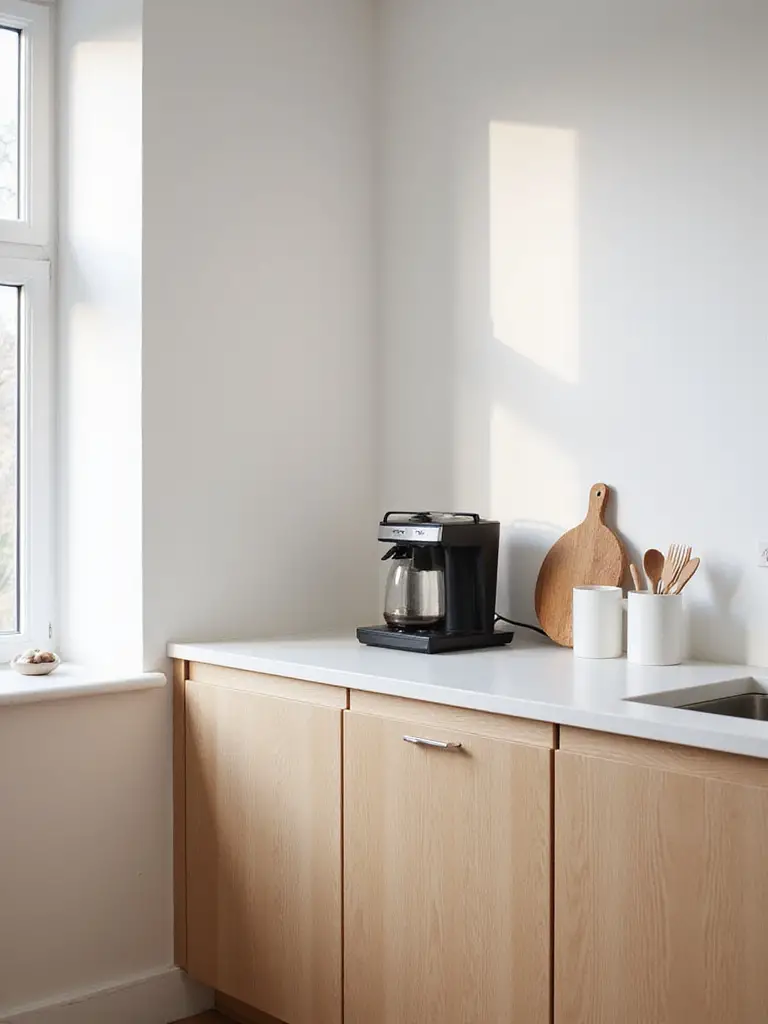
The process begins with complete decluttering, removing every item to assess what truly belongs on display. Essential appliances that earn countertop space typically include daily-use items like coffee makers or stand mixers, while decorative elements might include a single beautiful bowl or a small plant arrangement. The goal is creating breathing room that allows the eye to rest and appreciate the quality of materials and craftsmanship.
- Implement the daily reset: Return all items to designated homes each evening
- Choose multi-functional items: Select pieces that serve both practical and aesthetic purposes
- Create designated landing zones: Specific areas for keys, mail, or daily essentials
The styling mistake most people make is gradually allowing items to accumulate, slowly eroding the serene atmosphere that clear surfaces provide. Consistent maintenance prevents this drift and preserves the kitchen’s calming influence.
11. Select Integrated Appliance Solutions
Integrated appliances represent the pinnacle of Scandinavian kitchen decor, creating seamless visual flow by concealing modern conveniences behind custom cabinetry panels. This approach eliminates the visual interruption of mismatched finishes and bulky forms, allowing the kitchen’s architectural elements and natural materials to take precedence.
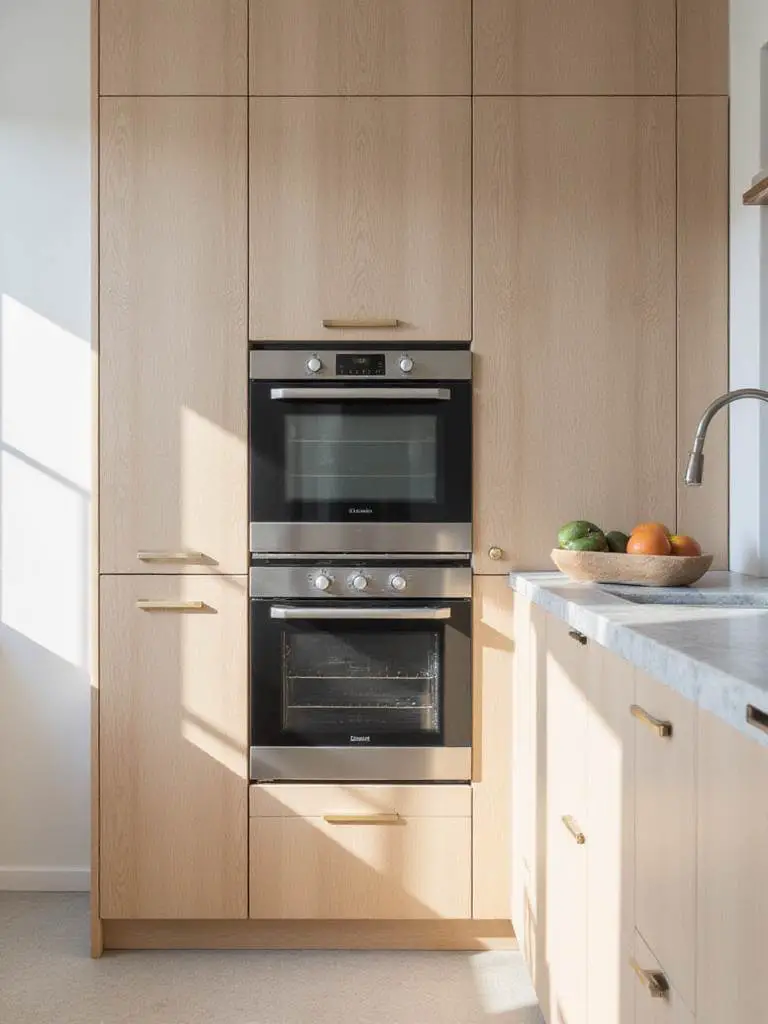
The planning process requires early coordination between appliance selection and cabinetry design, ensuring proper dimensions and ventilation while maintaining the illusion of continuous cabinetry. Panel-ready refrigerators, dishwashers, and even range hoods can disappear completely when properly integrated, creating a gallery-like serenity that defines Nordic design.
For kitchens where full integration isn’t feasible, selecting appliances with consistent finishes – particularly high-quality stainless steel with anti-fingerprint coatings – maintains visual coherence while providing professional functionality. The key lies in treating appliances as architectural elements rather than decorative features.
The artisans’ commitment to environmental practices means choosing energy-efficient models that align with Scandinavian values of resource conservation and long-term thinking.
12. Choose Ergonomic Bar Stool Seating
Bar stools in Scandinavian kitchen decor must balance comfort, functionality, and visual lightness to support the kitchen island’s role as a social hub without overwhelming the minimalist aesthetic. The selection process involves careful attention to proportions, materials, and ergonomic features that encourage lingering and conversation.
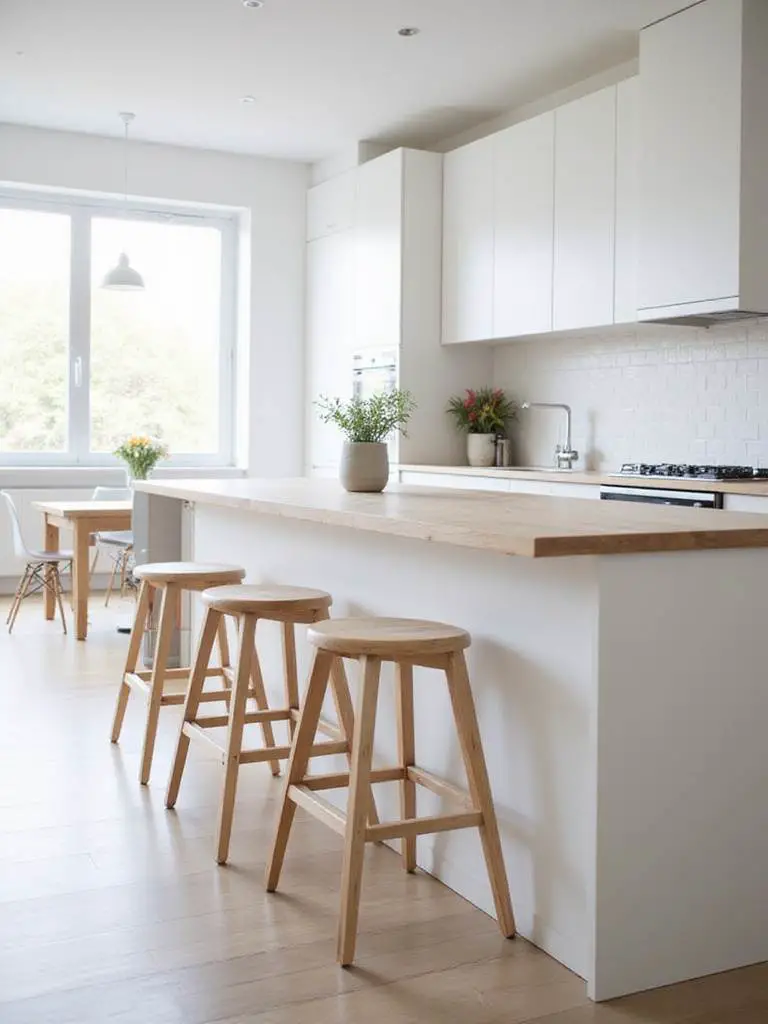
Proper scale requires measuring your island height to ensure 10-12 inches of clearance between seat and countertop, while considering whether stools should tuck completely under the overhang to maintain clean lines when not in use. Backless designs often work best for maintaining visual openness, though low backs can provide comfort without blocking sightlines.
- Prioritize comfort for extended sitting: Contoured seats and footrests reduce fatigue
- Choose durable, easy-clean materials: Solid wood, powder-coated metal, or high-quality plastics
- Consider stackable options: Space-saving solutions for flexible entertaining
The heritage technique gets a contemporary update through modern manufacturing methods that create comfortable, durable seating while maintaining the clean lines and natural materials that define Nordic aesthetics.
13. Display Artisanal Ceramic Collections
Ceramic pieces introduce essential warmth and human touch to Scandinavian kitchen decor, providing textural contrast to smooth wood and metal surfaces while showcasing the handcrafted quality that Nordic design celebrates. The curation process involves selecting pieces that balance utility with aesthetic appeal, creating displays that feel both intentional and lived-in.
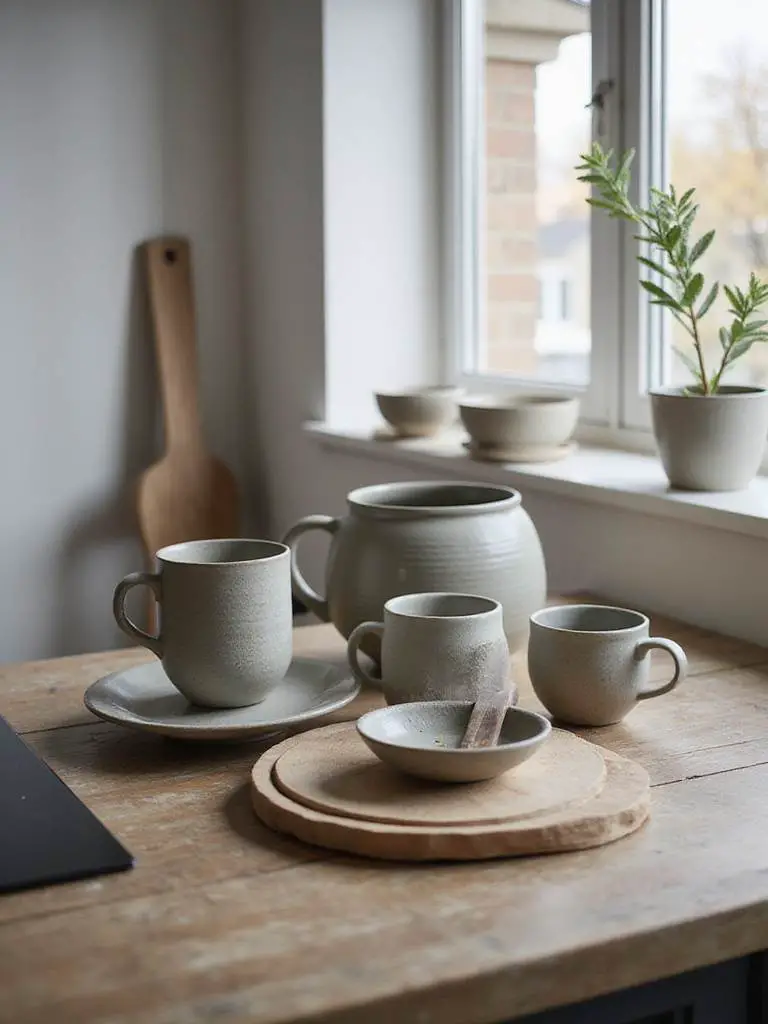
Handmade ceramics offer subtle variations in glaze, form, and texture that mass-produced items cannot replicate. These imperfections become features, adding character and authenticity that aligns with the Scandinavian appreciation for craftsmanship and natural beauty. The key lies in grouping pieces that share common elements – perhaps color family, finish quality, or maker – while allowing each piece individual space to be appreciated.
The display strategy involves creating vignettes on open shelving or within glass-front cabinets, using the rule of odds for visual appeal while leaving ample negative space. Functional pieces like serving bowls, mugs, or planters work particularly well, as they can transition seamlessly between display and daily use.
The cultural heritage preserved in each piece includes traditional techniques passed down through generations, connecting your modern kitchen to centuries of ceramic artistry and craftsmanship.
14. Implement Smart Drawer Organization
Drawer organization systems form the invisible foundation of Scandinavian kitchen decor, ensuring that the minimalist aesthetic extends beyond visible surfaces to create truly functional storage solutions. This approach involves creating designated spaces for every tool and utensil, preventing the accumulation of clutter that can undermine the kitchen’s serene atmosphere.
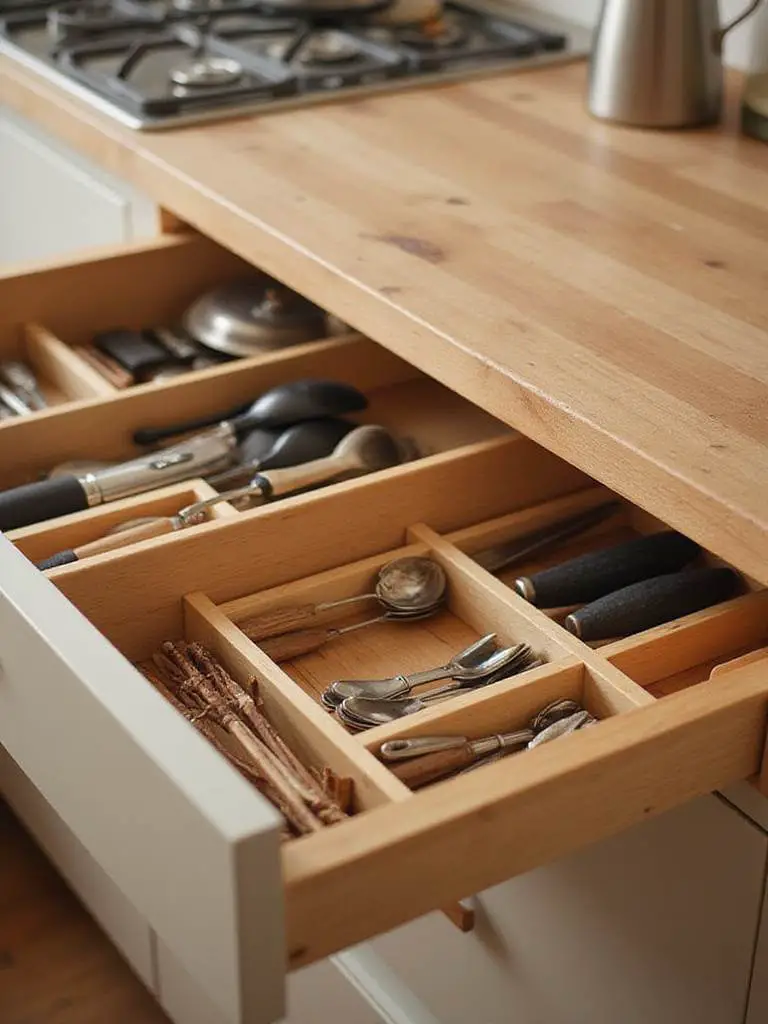
The system begins with complete inventory and categorization, grouping similar items and eliminating duplicates or rarely used gadgets. Custom inserts, adjustable dividers, and tiered organizers maximize vertical space within drawers while creating intuitive storage that makes meal preparation more efficient and enjoyable.
- Use adjustable bamboo dividers: Sustainable materials that complement Nordic aesthetics
- Implement vertical storage: Knife blocks and spice racks that utilize drawer depth
- Create dedicated zones: Specific areas for cooking tools, serving pieces, and daily essentials
The unexpected pairing that always works is combining visible organization with hidden storage, creating drawers that are both beautiful and functional when opened, maintaining the kitchen’s aesthetic integrity even in utilitarian spaces.
15. Add Subtle Cool-Toned Accents
Cool-toned accents in Scandinavian kitchen decor provide visual depth and psychological calm without disrupting the neutral foundation that defines Nordic design. Muted grays and soft blues serve as sophisticated counterpoints to warm wood tones, creating a balanced palette that feels both serene and sophisticated.
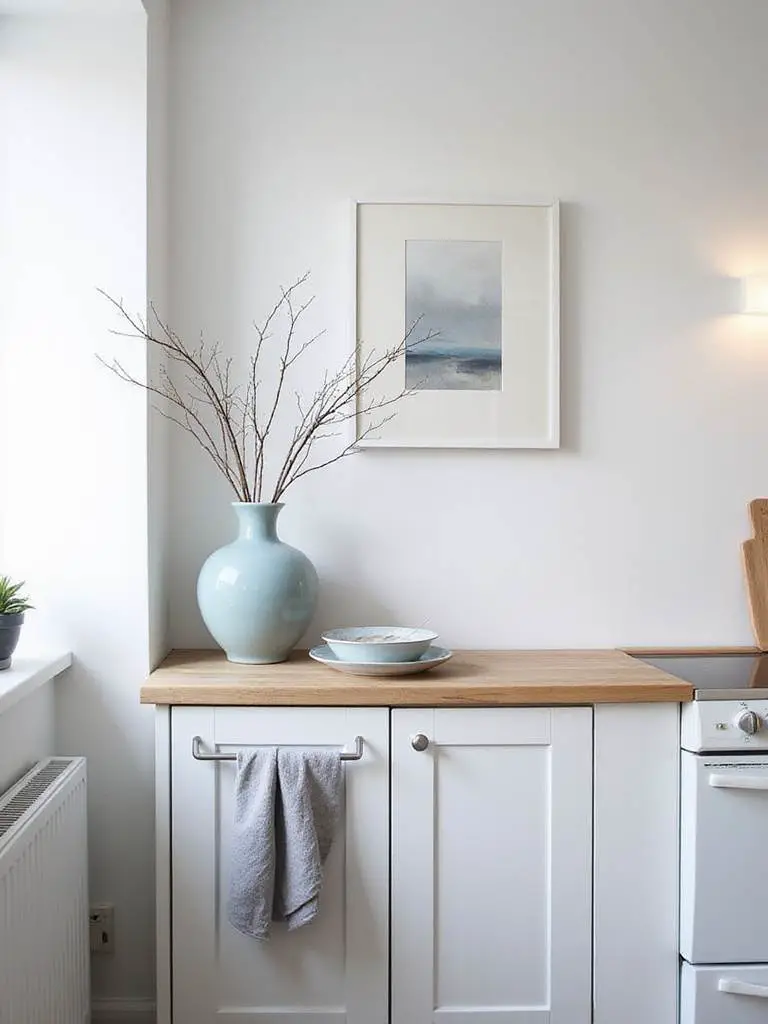
The strategic application of these accents involves restraint and intention – a single ceramic vase in dusty blue, linen tea towels in soft gray, or a small collection of matte pottery can provide sufficient color interest without overwhelming the minimalist aesthetic. The key lies in selecting desaturated tones that complement rather than compete with natural materials.
These accent colors work particularly well in textiles and ceramics, where they can be easily changed seasonally or as preferences evolve. The psychological impact of cool colors promotes feelings of tranquility and spaciousness, contributing to the kitchen’s role as a calming retreat from daily stress.
The evolution of this trend reflects broader cultural shifts toward mindful living and the recognition that our environments directly impact our mental well-being and daily satisfaction.
16. Incorporate Abstract Minimalist Art
Wall art in Scandinavian kitchen decor should enhance rather than dominate, providing subtle visual interest through abstract forms and muted palettes that complement the kitchen’s minimalist aesthetic. The selection process involves choosing pieces that create moments of contemplation without disrupting the space’s functional clarity.
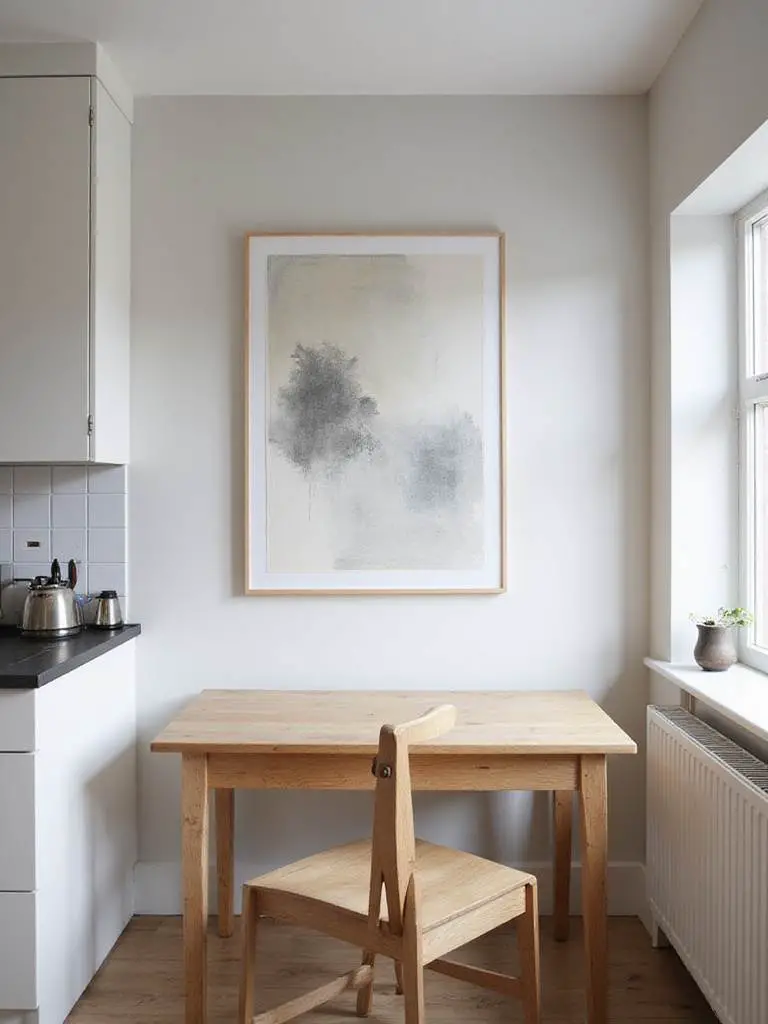
Abstract compositions work particularly well because they don’t compete with the kitchen’s practical elements or impose specific narratives on the space. Simple geometric forms, subtle color gradations, or textural compositions in neutral tones can add sophistication while maintaining the serene atmosphere essential to Nordic design.
- Choose pieces with restrained palettes: Grays, whites, and soft earth tones that complement existing finishes
- Consider scale carefully: Single large pieces often work better than multiple small artworks
- Frame simply: Natural wood or white frames that don’t distract from the artwork itself
The finishing touch that elevates the entire look involves proper placement at eye level with adequate surrounding space, allowing the artwork to breathe and contribute to the kitchen’s overall sense of calm and refinement.
17. Design Multi-Functional Kitchen Islands
Kitchen islands in Scandinavian kitchen decor serve as central command centers that maximize both workspace and social interaction while maintaining the clean lines and functional beauty that define Nordic design. The design process involves balancing storage, seating, and work surfaces within a form that enhances rather than overwhelms the kitchen’s proportions.
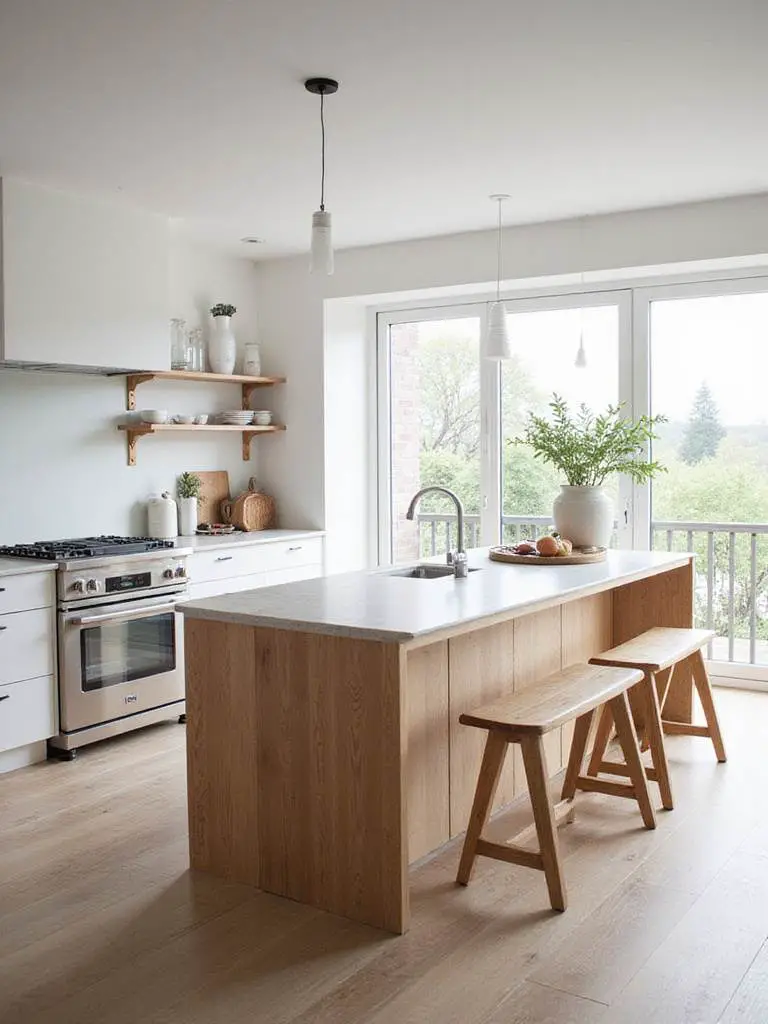
Effective island design requires careful attention to circulation patterns, ensuring adequate clearance for multiple users while creating distinct zones for food preparation, casual dining, and social interaction. Integrated storage solutions – from deep drawers to hidden recycling centers – maximize functionality while maintaining the uncluttered appearance essential to Scandinavian aesthetics.
The material selection typically mirrors the kitchen’s existing palette, using light wood, white quartz, or concrete surfaces that provide durability and easy maintenance. The goal is creating a piece that feels integral to the kitchen’s design rather than an added afterthought.
The challenge of awkward spaces becomes easier when the island serves multiple functions, potentially replacing separate dining areas or home office spaces in open-plan living environments.
18. Display Natural Linen Textiles
Linen textiles introduce essential softness and organic texture to Scandinavian kitchen decor, providing visual and tactile contrast to hard surfaces while embodying the Nordic appreciation for natural materials and honest craftsmanship. The selection and display of these textiles requires attention to both aesthetic and functional considerations.
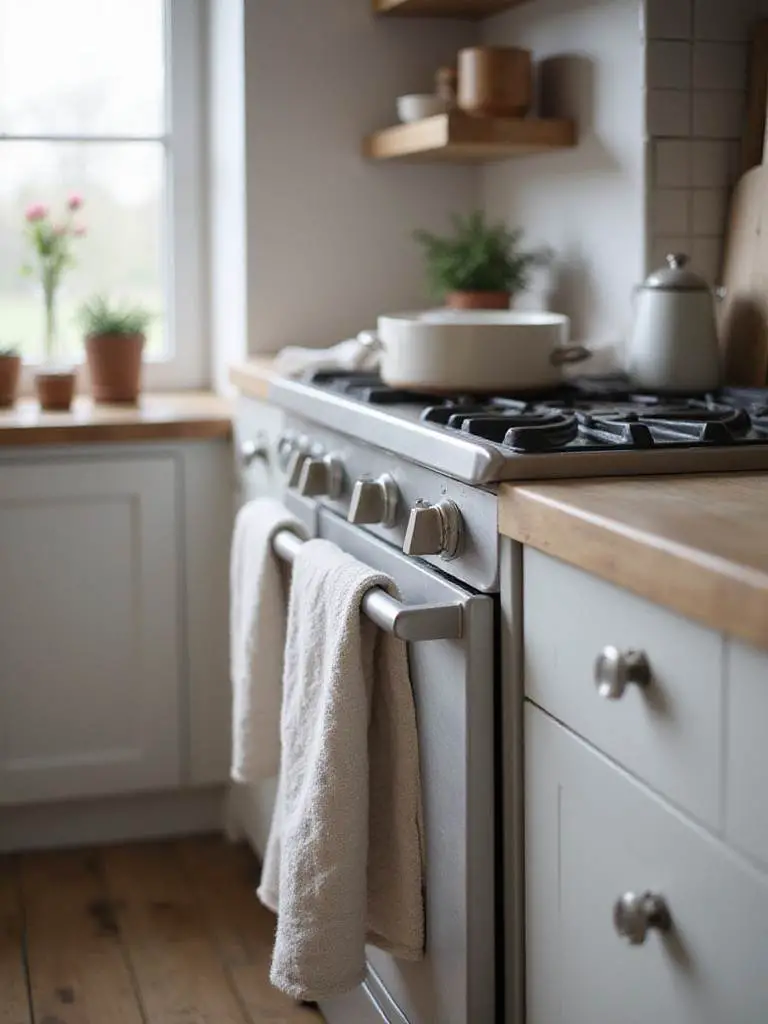
Quality linen improves with age and use, developing a relaxed character that aligns perfectly with the lived-in comfort that Scandinavian design promotes. Tea towels, placemats, and table runners in natural tones or subtle stripes add layers of texture without visual complexity, maintaining the serene atmosphere while providing practical functionality.
The display approach involves casual draping and folding that appears effortless but requires careful attention to proportion and placement. Linen’s natural tendency to wrinkle becomes a feature rather than a flaw, contributing to the authentic, unpretentious character that defines Nordic living.
The sustainable innovation narrative includes linen’s minimal environmental impact, requiring less water and chemicals than cotton while providing exceptional durability that supports the “buy less, buy better” philosophy.
19. Maximize Vertical Storage Potential
Vertical storage solutions in Scandinavian kitchen decor transform wall space into functional assets while maintaining the clean, uncluttered aesthetic through thoughtful organization and display. This approach involves utilizing every inch of available height while ensuring that storage solutions enhance rather than detract from the kitchen’s visual appeal.
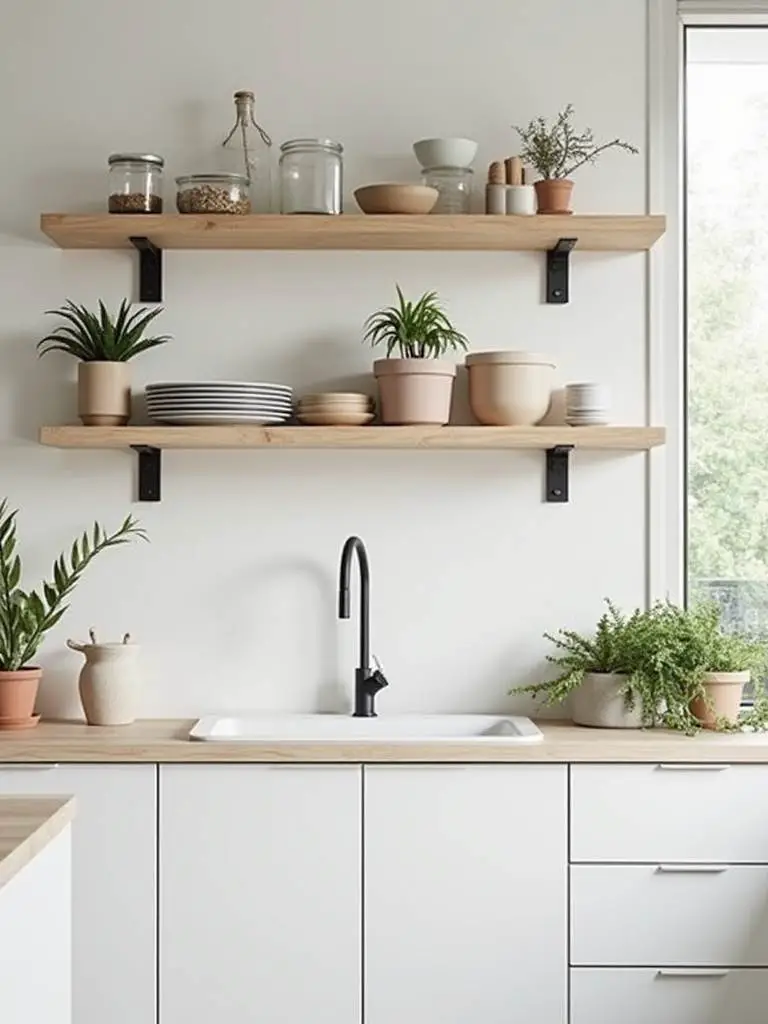
The strategy begins with assessing underutilized wall areas and determining the most appropriate storage solutions for different zones. Open shelving works well for frequently used items and attractive serving pieces, while closed cabinets handle less visually appealing necessities. Rail systems with hooks and magnetic strips provide flexible storage that can adapt to changing needs.
- Install ceiling-height cabinets: Maximize storage capacity while maintaining clean lines
- Use magnetic strips for knives: Space-saving solutions that keep blades sharp and accessible
- Implement rail systems: Flexible hanging storage that adapts to different tools and accessories
The professional stylists approach this by first creating zones for different types of storage, then selecting solutions that maintain visual coherence while maximizing functionality and accessibility.
20. Prioritize Sustainable Material Choices
Sustainable materials in Scandinavian kitchen decor reflect the deep Nordic connection to environmental stewardship while providing superior quality and unique aesthetic character. This approach involves selecting materials that minimize environmental impact while enhancing the kitchen’s natural beauty and longevity.
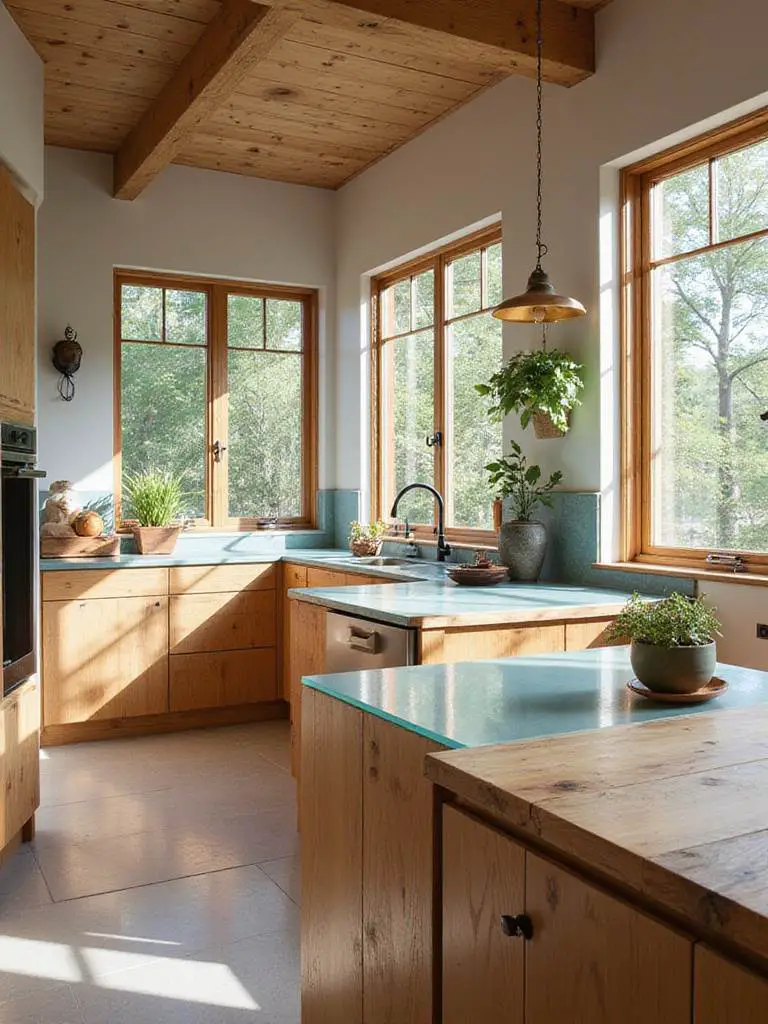
FSC-certified wood ensures responsible forest management, while reclaimed materials provide unique character and reduce demand for virgin resources. Recycled glass countertops and tiles offer distinctive visual texture while supporting circular economy principles that align with Scandinavian values.
The selection process involves researching material origins, manufacturing processes, and end-of-life considerations to make choices that support both environmental and aesthetic goals. Local sourcing reduces transportation impacts while often providing superior quality and unique regional character.
The forest where this walnut grew stands just miles from our workshop, representing the kind of local sourcing relationships that define truly sustainable design practices and connect your kitchen to its broader environmental context.
21. Create Intimate Breakfast Nooks
Breakfast nooks in Scandinavian kitchen decor embody the “hygge” philosophy by creating intimate spaces for daily rituals and informal gathering within the kitchen environment. These cozy corners transform underutilized areas into functional dining spaces that promote connection and contemplation.
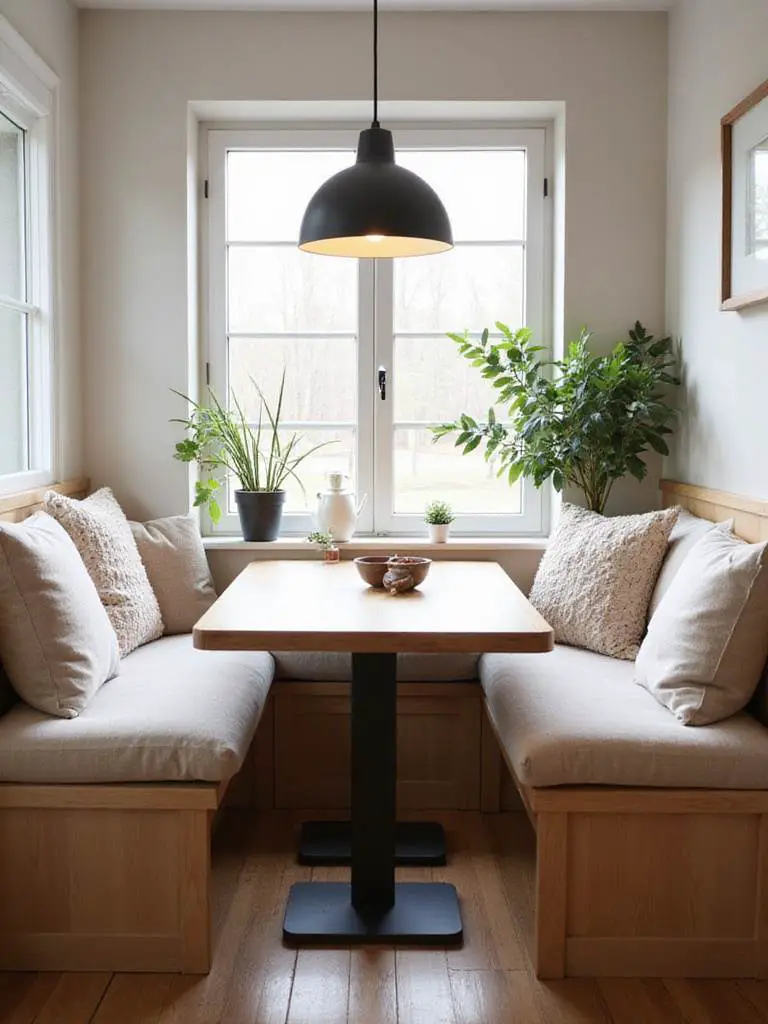
The design process involves identifying optimal locations – often bay windows, corners, or kitchen extensions – that offer natural light and proximity to food preparation areas. Built-in seating with hidden storage maximizes space efficiency while maintaining clean lines, often paired with simple tables that can serve multiple functions throughout the day.
- Incorporate built-in storage: Benches with lift-top seats provide hidden organization
- Add soft textiles: Cushions and throws that invite lingering and comfort
- Ensure adequate lighting: Natural light supplemented by warm artificial options
The mood shifts dramatically when you add textiles and plants that soften the architectural elements, creating spaces that feel both designed and lived-in, supporting the daily rhythms that define Nordic living.
22. Invest in Heirloom-Quality Utensils
Quality utensils represent the Scandinavian kitchen decor principle of “buy once, buy well,” selecting tools that provide superior performance while developing character through years of use. This approach involves choosing implements that balance functionality, durability, and aesthetic appeal to create a curated collection that enhances rather than clutters the cooking experience.
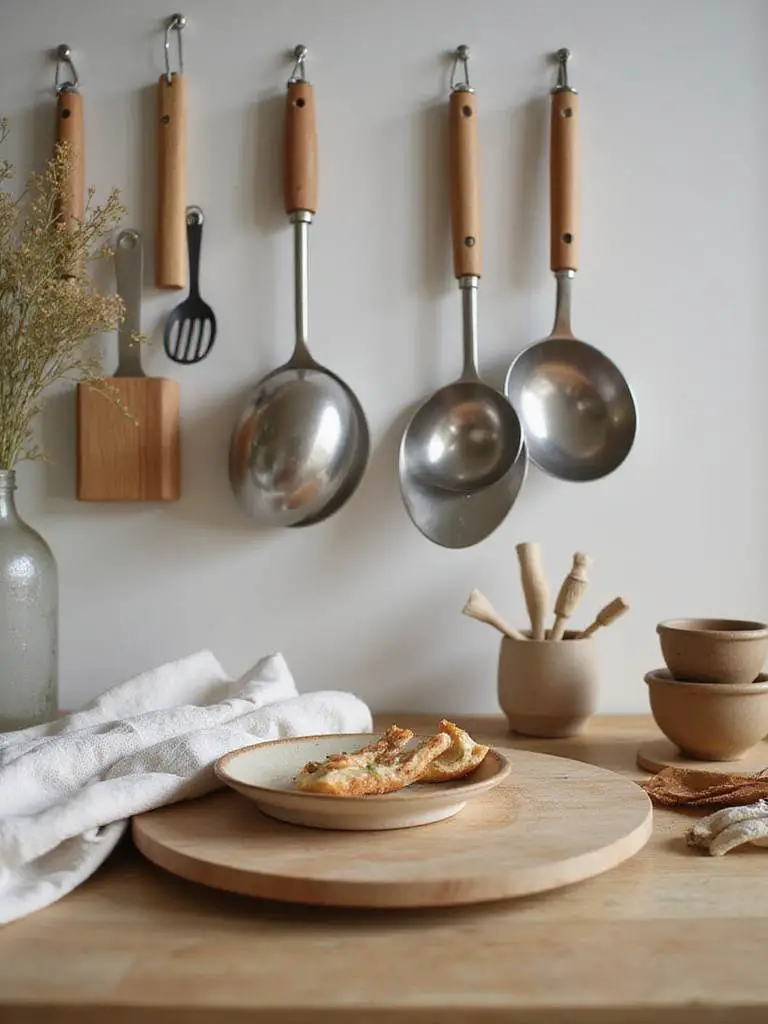
The selection process prioritizes materials known for longevity – high-grade stainless steel, sustainably harvested hardwoods, and heat-resistant silicones that maintain their properties through countless cooking cycles. Ergonomic design ensures comfort during extended use, while timeless aesthetics ensure these tools remain visually appealing as kitchen styles evolve.
Professional-grade tools often provide superior performance that makes cooking more enjoyable and efficient, while their durability eliminates the waste and frustration associated with frequently replacing inferior implements. The goal is creating a collection where every piece serves a clear purpose and brings satisfaction to daily use.
The traditional methods used result in tools that improve with age, developing patina and character that reflects their history of faithful service in your kitchen.
23. Organize with Natural Woven Baskets
Woven baskets provide elegant storage solutions in Scandinavian kitchen decor, concealing necessary clutter while introducing organic textures and natural materials that soften the kitchen’s geometric elements. The selection and placement of these containers requires balancing functional needs with aesthetic contribution.
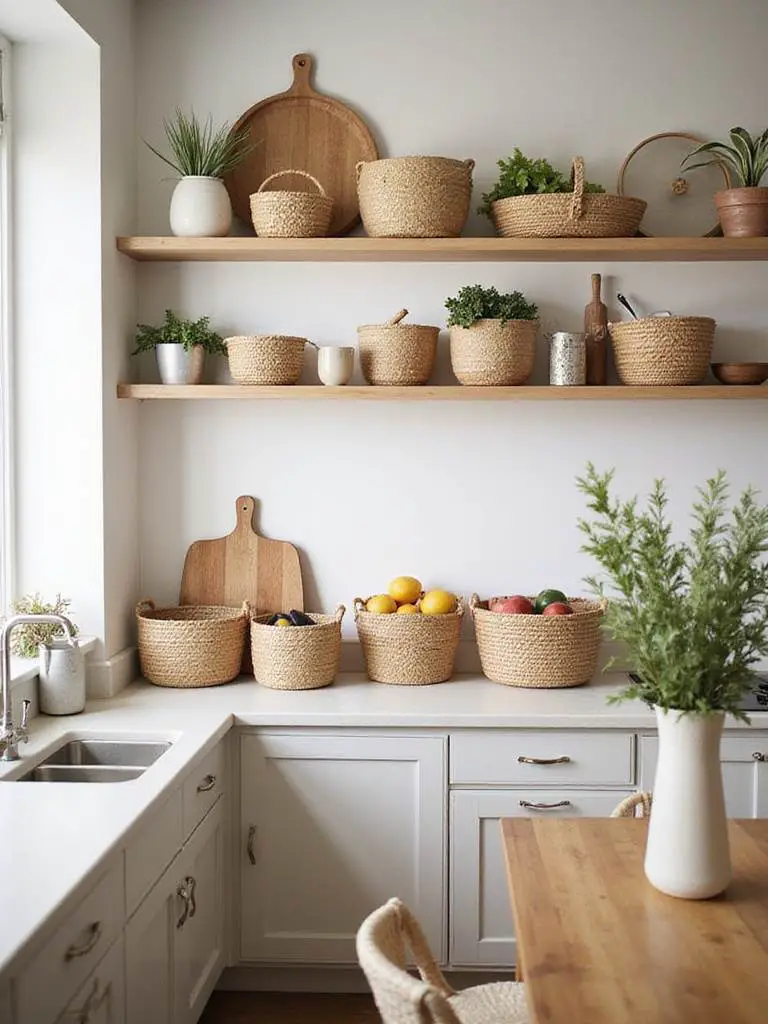
Natural materials like seagrass, rattan, and jute offer varying textures and durability levels appropriate for different storage needs. Produce storage benefits from breathable materials, while pantry organization might require more structured forms. The key lies in selecting baskets that share common elements – perhaps material, color, or weave pattern – while serving diverse functional needs.
- Choose appropriate sizes: Match basket dimensions to storage needs and available space
- Select durable construction: Ensure baskets can handle intended contents and regular use
- Coordinate materials: Maintain visual coherence through consistent natural fibers
The artisan collective that creates these pieces often employs traditional techniques passed down through generations, connecting your modern kitchen to centuries of basketmaking heritage while supporting sustainable craft traditions.
24. Plan Intuitive Workflow Zones
Workflow zones form the invisible infrastructure of Scandinavian kitchen decor, organizing space and storage to support efficient cooking processes while maintaining the clean, uncluttered aesthetic that defines Nordic design. This systematic approach involves creating logical relationships between appliances, storage, and work surfaces.
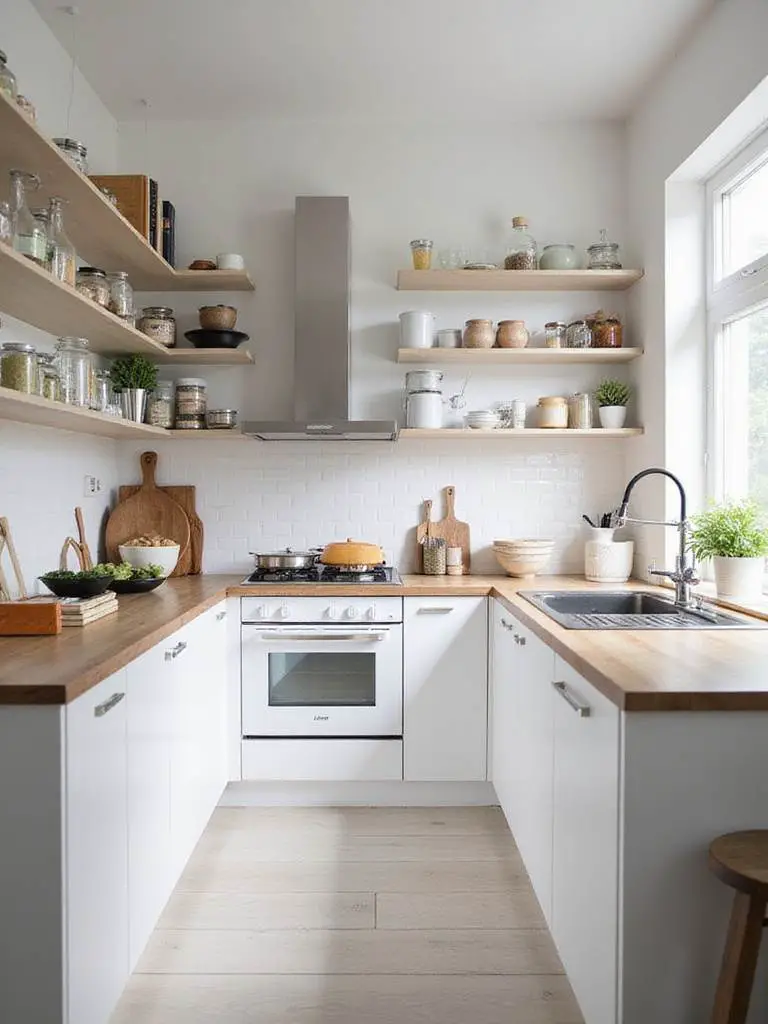
The traditional work triangle – connecting refrigerator, sink, and stove – provides the foundation for efficient movement, while additional zones for coffee preparation, baking, or cleanup create specialized areas that prevent congestion and improve functionality. Storage placement should support these zones, keeping tools and ingredients close to their points of use.
Modern kitchen design expands beyond the triangle to consider how multiple users share the space, creating parallel work areas and ensuring adequate circulation. The goal is designing intuitive flow that feels natural and reduces the steps required for common tasks.
The discovery of this technique happened when designers began studying professional kitchen efficiency and adapting those principles to residential spaces, creating kitchens that work as hard as they look beautiful.
Conclusion
Creating a serene Scandinavian kitchen decor environment is ultimately about embracing the Nordic philosophy that true luxury lies in simplicity, functionality, and connection to natural materials. Through these 24 essential ideas, we’ve explored how thoughtful design choices – from maximizing natural light to selecting sustainable materials – can transform your kitchen into a sanctuary that nurtures both daily routines and special moments of gathering.
The journey toward Scandinavian serenity requires patience and intentionality, gradually curating elements that serve both practical and aesthetic purposes while eliminating anything that doesn’t contribute to the overall sense of calm. This approach creates kitchens that feel both timeless and contemporary, supporting the rhythms of daily life while providing visual respite from our increasingly complex world.
Ready to begin your transformation? Start with a single element – perhaps clearing your countertops or adding a carefully chosen plant – and observe how that change influences the entire space. As you implement these Scandinavian kitchen decor principles, you’ll discover that creating serenity is less about perfection and more about mindful choices that reflect your values and support your daily well-being.
